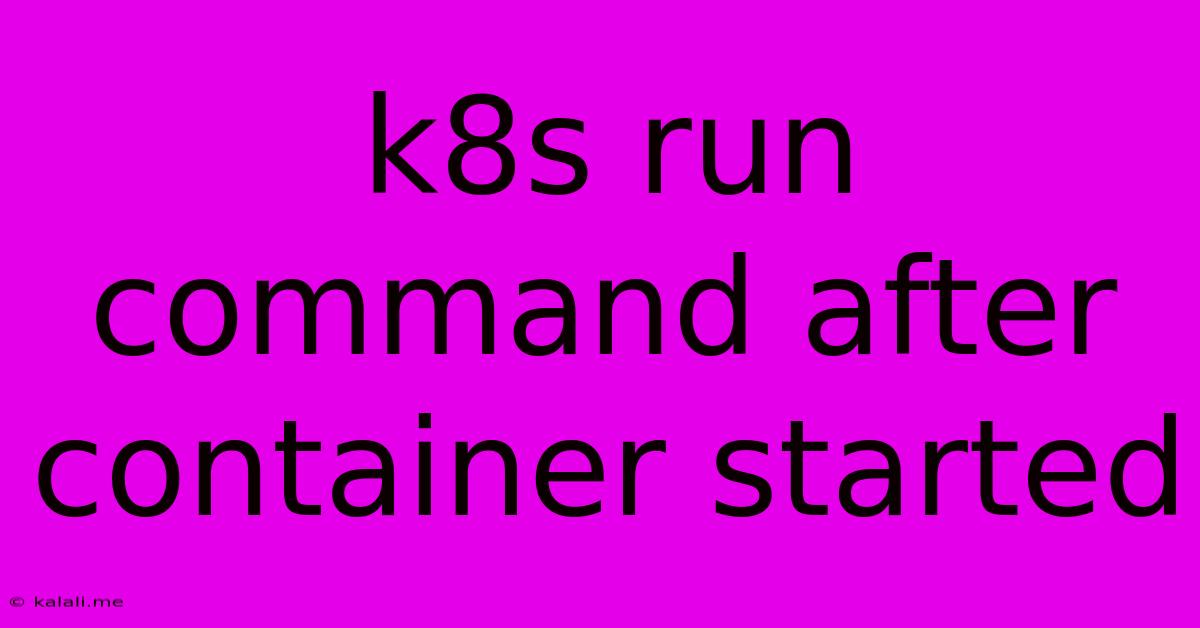K8s Run Command After Container Started
Kalali
Jun 10, 2025 · 3 min read

Table of Contents
Running Commands in Kubernetes Pods After Container Start
Kubernetes provides robust mechanisms for managing containers within pods. However, sometimes you need to execute commands after a container has successfully started. This article explores several effective methods for achieving this, focusing on best practices and avoiding common pitfalls. Understanding these methods is crucial for tasks like running post-startup configurations, database migrations, or one-time setup scripts within your Kubernetes deployments.
This guide details various approaches to executing commands post-container startup, covering their advantages, disadvantages, and appropriate use cases. We'll delve into techniques like using init containers, sidecars, and Kubernetes jobs.
Understanding the Challenge
The core issue lies in the asynchronous nature of container startup within a pod. Simply including a command within your main container's Dockerfile doesn't guarantee execution after the container's services and dependencies are fully initialized. This can lead to errors if the command relies on resources that haven't yet become available.
Method 1: Init Containers
Init containers run before the main application container(s). They're ideal for tasks like setting up configurations, downloading dependencies, or performing initial database migrations. Once the init container completes successfully, the main container starts.
Advantages:
- Guaranteed execution: Init containers run to completion before the main containers start.
- Simple implementation: Relatively straightforward to configure within your pod definition.
Disadvantages:
- Blocking: If the init container fails, the entire pod will fail to start.
- Not suitable for ongoing tasks: Init containers are designed for one-time setup tasks.
Example:
apiVersion: v1
kind: Pod
metadata:
name: my-pod
spec:
initContainers:
- name: init-container
image: busybox
command: ["sh", "-c", "sleep 10 && touch /tmp/initialized"]
containers:
- name: my-container
image: my-app
command: ["/bin/sh", "-c", "while true; do echo 'App running'; sleep 1; done"]
This example uses busybox to simulate a setup task. After a 10-second delay, it creates a file indicating completion. The my-app container then starts.
Method 2: Sidecar Containers
Sidecar containers run concurrently with your main application container(s). They are suitable for tasks that need to run continuously alongside the main application, such as logging, monitoring, or interacting with external services.
Advantages:
- Concurrent execution: The sidecar runs alongside the main container.
- Flexibility: Suitable for both one-time and ongoing tasks.
Disadvantages:
- Resource consumption: Sidecars consume resources alongside the main container.
- Requires careful orchestration: Requires meticulous coordination between the main container and the sidecar.
Example (Illustrative – requires specific logic within the sidecar container):
apiVersion: v1
kind: Pod
metadata:
name: my-pod
spec:
containers:
- name: my-container
image: my-app
# ...
- name: sidecar-container
image: my-sidecar
command: ["/bin/sh", "-c", "sleep 30; echo 'Sidecar task complete'; while true; do sleep 1; done"]
Here, a sidecar container executes a command after a 30-second delay and then continues running.
Method 3: Kubernetes Jobs
Kubernetes Jobs are designed for finite tasks. They're useful for executing commands once and then completing. This is suitable for situations where you need a command to run only once, perhaps after a deployment is updated.
Advantages:
- Ideal for one-time tasks: Completes execution automatically.
- Resource management: Kubernetes automatically manages job resources.
Disadvantages:
- Not suitable for ongoing tasks: Jobs are designed for completion.
- Requires separate job definition: Adds complexity to the deployment process.
Example:
You would define a separate Job YAML file to run your post-startup command. This job would likely be triggered by a Kubernetes event like a deployment update.
Choosing the Right Method
The optimal approach depends on your specific needs:
- One-time, pre-application startup: Use init containers.
- Ongoing tasks alongside the application: Use sidecar containers.
- One-time tasks independent of the main application: Use Kubernetes Jobs.
Remember to carefully consider resource usage and potential failure scenarios when implementing any of these methods. Proper error handling and logging are crucial for maintaining a robust and reliable Kubernetes deployment.
Latest Posts
Latest Posts
-
Which Of The Following Is Not A True Statement
Jun 12, 2025
-
What Calendar Year Is The Same As 2026
Jun 12, 2025
-
Which Of The Following Is Not A Connective Tissue
Jun 12, 2025
-
How Do You Spell 80 In Words
Jun 12, 2025
-
Which Of The Following Is An Example Of A Simile
Jun 12, 2025
Related Post
Thank you for visiting our website which covers about K8s Run Command After Container Started . We hope the information provided has been useful to you. Feel free to contact us if you have any questions or need further assistance. See you next time and don't miss to bookmark.